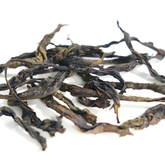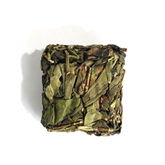What Does Oolong Tea Taste Like? A Flavor Guide from Light to Bold
"When I first tried oolong tea, I thought I had accidentally swallowed my grandma’s perfume."—That’s how one of my foreign tea-loving friends described their first experience with Tieguanyin. Many international customers are surprised by the complex flavor of oolong tea—it’s not as light and refreshing as green tea, nor as bold and strong as black tea. Instead, it finds the perfect balance between the two.
Oolong tea is one of the most iconic types of Chinese tea, known for its captivating aroma. It has been gaining popularity worldwide, yet for many foreign tea lovers, describing its taste can be quite challenging. American tea expert Jane Pettigrew once said, "Oolong tea offers a journey of flavors, from floral and fruity to roasted and woody." Some American tea drinkers even mistake oolong for green tea.
So, what does oolong tea really taste like? If you’ve never tried it before or have only had it once without fully understanding its flavor, don’t worry. This article will break it down in a simple and approachable way, using insights from tea experts to help you truly appreciate the unique taste of Chinese oolong tea.
What is oolong tea?
Oolong tea is a semi-fermented tea and one of the six major types of Chinese tea. Its level of fermentation falls between that of green tea and black tea, giving it a rich aroma and a complex, layered flavor. The fermentation level typically ranges from 15% to 70%, resulting in a wide variety of tastes and fragrances.
The main production regions of oolong tea include Fujian, Guangdong, and Taiwan. In Fujian, Wuyi Rock Tea (such as Da Hong Pao) and Anxi Tieguanyin are the most representative oolong teas; Guangdong is famous for Phoenix Dan Cong, while Taiwan is well-loved for varieties like Dong Ding Oolong and High Mountain Oolong. Modern science has confirmed that oolong tea contains over three times the aromatic compounds found in green tea.
The origins of oolong tea can be traced back to the Ming and Qing dynasties. Oolong tea was born in Anxi, Fujian, and traditional legend has it that during the Qing Dynasty, a tea farmer named Su Long accidentally discovered the semi-fermentation process when he delayed processing his tea due to a hunting trip (around 1725). Over time, this unique method evolved into the oolong tea-making process we know today. Today, oolong tea is popular worldwide for its distinctive flavor, rich taste, and potential health benefits.
What does oolong tea taste like?
Oolong tea has a wide range of flavors, mainly depending on its oxidation level. Based on the level of oxidation, oolong tea can be roughly divided into lightly oxidized (fragrant type with 15%-30% oxidation) and carbon-roasted oolong tea (rich type with 50%-85% oxidation). The flavor differences between these two types are significant and can be compared to two completely different experiences. Think of it like coffee choices in the U.S.—lightly oxidized oolong is like a refreshing cold brew coffee, while carbon-roasted oolong is like a rich caramel macchiato. You can find detailed information based on the product labels; although the flavors are very different, both types fall under the category of oolong tea.
What does lightly oxidized oolong tea taste like?
Typical examples: Dong Ding Oolong, Anxi Tieguanyin, Wenshan Baozhong,Zhangpingshuixain
Lightly oxidized oolong tea has a refreshing taste with floral and fruity notes, similar to the aroma of fresh white peaches, orchids, or jasmine flowers. The tea liquor is lighter in color and has a smooth, slightly sweet flavor. Some varieties even have a sweet, floral fragrance, reminiscent of orchids, jasmine, or white peaches. It’s smooth and refreshing with a noticeable aftertaste, making it ideal for those who enjoy lighter flavors. If you typically enjoy fruit teas or lightly roasted coffee, this oolong tea would be a great choice for you. Brewing suggestions: For lightly oxidized oolong tea (such as Dong Ding Oolong), it’s best to use water at 85-90°C with a tea-to-water ratio of 1:20 (about 7g of tea per 150ml of water). First, quickly rinse the tea, then brew it in a gaiwan with a quick infusion (5-10 seconds for the first brew, gradually increasing for subsequent brews). This tea can be steeped 5-7 times. Be careful to avoid high temperatures and long steeping times, as this can release too much tannin and make the tea bitter. Also, avoid using mugs or thermal cups for brewing.
Brewing suggestions: For lightly oxidized oolong tea (such as Dong Ding Oolong), it’s best to use water at 85-90°C with a tea-to-water ratio of 1:20 (about 7g of tea per 150ml of water). First, quickly rinse the tea, then brew it in a gaiwan with a quick infusion (5-10 seconds for the first brew, gradually increasing for subsequent brews). This tea can be steeped 5-7 times. Be careful to avoid high temperatures and long steeping times, as this can release too much tannin and make the tea bitter. Also, avoid using mugs or thermal cups for brewing.
What does strongly oxidized oolong tea taste like?
Typical examples: Wuyi Da Hong Pao, Shui Xian, Phoenix Dan Cong
Strongly oxidized oolong tea has a deeper tea liquor color, with a rich, full-bodied taste that carries the aromas of nuts, caramel, and even roasted coffee. If you enjoy the scents of roasted almonds, toasted bread, dark chocolate, or the caramel notes found in whiskey, you might enjoy this type of oolong tea. Its aftertaste is long-lasting, with a warm, toasty grain scent upon entry, reminiscent of freshly baked oatmeal cookies. Sometimes, you may also taste maple syrup or roasted nuts. Compared to lightly oxidized oolong tea, this type of oolong is more suitable for those who enjoy deeply roasted coffee or black tea. Strongly oxidized oolong tea may not be ideal for beginners, as its flavor is generally stronger. Brewing suggestions: Strongly oxidized oolong tea is best brewed with boiling water to fully release its rich fragrance. It’s recommended to use a gaiwan with a tea-to-water ratio of 1:20 (about 7.5g of tea per 150ml of water). Brew quickly in the gaiwan (5-10 seconds for the first infusion, gradually increasing for subsequent brews). This tea can be steeped multiple times. A slight resting time can enhance the richness of the tea, but avoid steeping for too long to prevent bitterness. Also, avoid using mugs or thermal cups for brewing.
Brewing suggestions: Strongly oxidized oolong tea is best brewed with boiling water to fully release its rich fragrance. It’s recommended to use a gaiwan with a tea-to-water ratio of 1:20 (about 7.5g of tea per 150ml of water). Brew quickly in the gaiwan (5-10 seconds for the first infusion, gradually increasing for subsequent brews). This tea can be steeped multiple times. A slight resting time can enhance the richness of the tea, but avoid steeping for too long to prevent bitterness. Also, avoid using mugs or thermal cups for brewing.
Common Varieties of Oolong Tea (Based on Flavor Profile)
Oolong tea can be divided into two main categories based on oxidation level and roasting process: lightly oxidized (fragrant) oolong tea and strongly oxidized (rich) oolong tea. The flavor difference between these two types is like comparing a fresh fruit platter to a caramel pudding. Below are some typical examples. When purchasing oolong tea, you can ask the seller or check the product label to identify the type of oolong, which will give you a good idea of what the tea will taste like
| Type | Tea Name | Oxidation Level | Flavor Profile | Origin |
|---|---|---|---|---|
| Light Oolong | Tieguanyin | 15%-25% | Orchid floral, fresh-cut grass | Anxi, Fujian (China) |
| Wenshan Baozhong | 10%-20% | Jasmine blossom, sweet pea shoots | Taipei (Taiwan) | |
| Dong Ding | 20%-30% | Creamy milk, osmanthus honey | Nantou (Taiwan) | |
| Bold Oolong | Da Hong Pao | 50%-70% | Caramelized sugar, mineral & roasted chestnut notes | Wuyi Mountain (China) |
| Rou Gui | 40%-60% | Cinnamon spice, baked apricot | Wuyi Mountain (China) | |
| Phoenix Dan Cong | 30%-50% | Honey orchid, toasted almond | Fenghuang Mountain (China) | |
| Oriental Beauty | 60%-70% | Honey, dried fruit | Hsinchu (Taiwan) |
Quick Answers About Oolong Tea
1. Is oolong tea caffeinated?
Yes! Oolong has caffeine—like a light coffee or cola. Great for a gentle energy boost.
2. Is oolong tea black tea?
No! Black tea is fully oxidized (think dark and bold). Oolong is halfway between green and black tea.
3. Is oolong tea green tea?
Nope! Green tea stays "fresh" (no oxidation), while oolong gets a little "time in the sun" for richer flavors.
4. Does oolong tea make you poop?
Maybe! Like coffee, caffeine can get things moving. But it’s gentle—no "emergency exit" vibes.
5. Is oolong tea herbal?
No. Herbal teas are caffeine-free (like chamomile). Oolong comes from real tea leaves.
6. Where is oolong tea from?
Born in China (Fujian/Taiwan), but now grown everywhere—like how pizza left Italy and became everyone’s.
SEE MORE ABOUT CHINESE TEAS
If you have questions about selecting tea:
Learn-more-about-chinese-tea
If you have questions about the benefits of tea:
Health-benefits-of-chinese-tea
If you have questions about brewing tea:
How-to-brew-loose-leaf-tea






